Part 47
Update 46: Killing the Name(s)
First, some fusion. Probably the last time I do fusion, probably.

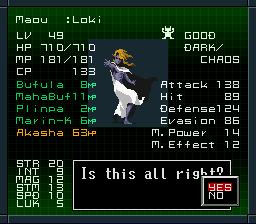
Who knew that Loki would be made with those two? Not me, but I could've known if I had used Re-Miel's fusion chart. I am normally too damn lazy to use it, but I DID use it when I tried to get Astaroth.
And of course, you can upgrade/downgrade demons as you please with Seirei.code:
Race| Mj Mg Am Hs Jb Kn Yo Ya Ys Da Ts Dt Rj Ro Rc Yc Sj Ej Aj Kj Yk Cr Dm -------------------------------------------------------------------------- Mj | -- ** ** -- Mg Hs Mg Yo Ya -- Mg Hs Hs Rj Da Dt Hs Sj Sj Jb Kn Kn Yj Mg | -- ** Mo Mj Jb Am Mo Yo -- Dt Mj Jb Rj Rj Dt Hs Mj Sj Rj Jb Jb Jr Am | %% Da Mg Mj Mg Dt Ts Mj Rc Yc Mj Mg Da Mg Mj Da Ej Hs Sj Kn Yc Hs | -- ** ** Sj Js Yk Js Am Js Js Rj Rj Jb Mj Mj Rj Js Js Tj Kn Jb | -- ** Mg Hs Kj Mg Da Mo Mj Rj Rj Mg Rj Mg Ro Js Kn Kj Kj Kn | %% Kj Jb Mg Hs Rj Ro Hs Jb Am Jb Rj Hs Ro Hs Ro Ro Cr Yo | %% ** ** Mo Dt Ya Jb Rc Ro Dt Hs Jr Yk Ro Kj Ys Ya Ya | %% ** Yo Yc Yo Ro Jr Dt Yo Aj Yj Yc Jr Jk Aj Uk Ys | %% Ts Yc Ts Sj Ej Ts Dt Ro Aj Ej Yc Dt Yk Cr Da | -- ** ** Hs Rj Mg Rc Mj Sj Sj Mg Kn Mg Js Ts | %% ** Js Ej Mg Ys Rj Sj Dt Rc Yo Yk Ya Dt | %% Jr Kj Yo Ya Yo Aj Yk Yc Yo Jk Uk Rj | -- ** Hs Am Jb Kn Kn Kn Kn Js Ro Ro | %% Rj Kj Kn Rj Ej Yk Dt Kn Jr Rc | %% ** Am Sj Ej Mg Ya Yo Yc Yc | %% Rc Rc Yk Rc Kj Ys Kc Sj | %% ** ** Ya Ro Jb Ej Ej | %% ** Jb Aj Ro Aj Aj | %% Ya Yj Yk Yj Kj | %% ** ** Yk Yk | %% ** Cr Cr | %% Jk Dm | %% -------------------------------------------------------------------------- Race| Mj Mg Am Hs Jb Kn Yo Ya Ys Da Ts Dt Rj Ro Rc Yc Sj Ej Aj Kj Yk Cr Dm Mj: Majin Mg: Megami Am: Amatsukami Hs: Hakaishin Jb: Jiboushin Kn: Kunitsukami Yo: Youma Ya: Yama Ys: Yousei Da: Daitenshi Ts: Tenshi Dt: Datenshi Rj: Ryuujin Ro: Ryuu-Ou Rc: Reichou Yc: Youchou Sj: Shinjuu Ej: Seijuu Aj: Majuu Kj: Kijo Yk: Youki Cr: Chirei Dm: Demonoid Js: Jashin Mo: Maou Jr: Jaryuu Kc: Kyouchou Yj: Youjuu Jk: Jaki Uk: Yuuki Oj: Youju Sk: Shiki Ar: Akuryou Gd: Gedou Symbol Explanation: %% - Seirei (Elemental) race demon
Let's see what else is fuseable right now.
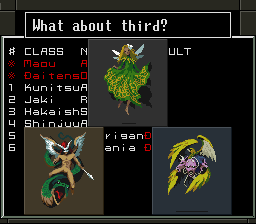
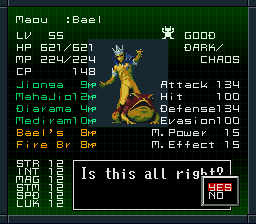
A Bael!
Megaten Wiki posted:
In Enochian demonology, Bael is the demon king of the East. His name is almost certainly derived from Baal.

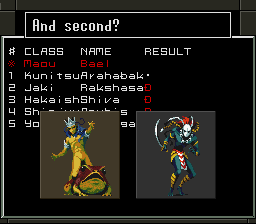
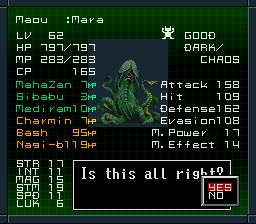
Hahah, oh wow.
As you can see, Mara's fusion is INCOMPLETE.
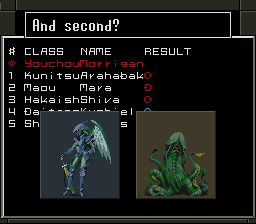

And that is THE top Maou. No fly form, but should be good enough for what is next.
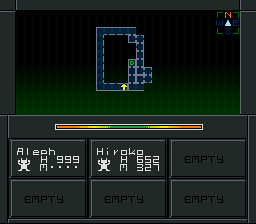 Goin' up.
Goin' up.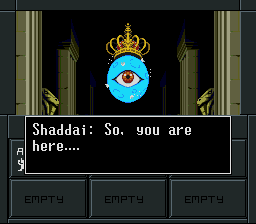
SHADDAI
Wikipedia posted:
Shaddai was a late Bronze Age Amorite city on the banks of the Euphrates river, in northern Syria. The site of its ruin-mound is called Tell eth-Thadyen: "Thadyen" being the modern Arabic rendering of the original West Semitic "Shaddai". It has been conjectured that El Shaddai was therefore the "god of Shaddai" and associated in tradition with Abraham, and the inclusion of the Abraham stories into the Hebrew Bible may have brought the northern name with them (see Documentary hypothesis).
In the vision of Balaam recorded in the Book of Numbers 24:4 and 16, the vision comes from Shaddai along with El. In the fragmentary inscriptions at Deir Alla, though Shaddai is not, or not fully present,[4] shaddayin appear, less figurations of Shaddai.[5] These have been tentatively identified with the ŝedim of Deuteronomy 34:17 and Psalm 106:37-38,[6] who are Canaanite deities.
According to Exodus 6:2, 3, Shaddai is the name by which God was known to Abraham, Isaac, and Jacob. The name Shaddai (Hebrew: שַׁדַּיis used as a name of God later in the Book of Job.
In the Septuagint and other early translations Shaddai was translated with words meaning "Almighty". The root word "shadad" (שדדmeans "to overpower" or "to destroy". This would give Shaddai the meaning of "destroyer" as one of the aspects of God. Thus it is essentially an epithet. Harriet Lutzky has presented evidence that Shaddai was an attribute of a Semitic goddess, linking the epithet with Hebrew šad "breast" as "the one of the Breast", as Asherah at Ugarit is "the one of the Womb".[7]
Another theory is that Shaddai is a derivation of a Semitic stem that appears in the Akkadian shadû ("mountain") and shaddā`û or shaddû`a ("mountain-dweller"), one of the names of Amurru. This theory was popularized by W. F. Albright but was somewhat weakened when it was noticed that the doubling of the medial d is first documented only in the Neo-Assyrian period. However, the doubling in Hebrew might possibly be secondary. In this theory God is seen as inhabiting a mythical holy mountain, a concept not unknown in ancient West Asian mythology (see El), and also evident in the Syriac Christian writings of Ephrem the Syrian, who places Eden on an inaccessible mountaintop.
An alternative view proposed by Albright is that the name is connected to shadayim which means "breasts" in Hebrew. It may thus be connected to the notion of God’s fertility and blessings of the human race. In several instances it is connected with fruitfulness: "May God Almighty [El Shaddai] bless you and make you fruitful and increase your numbers…" (Gen. 28:3). "I am God Almighty [El Shaddai]: be fruitful and increase in number" (Gen. 35:11). "By the Almighty [El Shaddai] who will bless you with blessings of heaven above, blessings of the deep that lies beneath, blessings of the breasts [shadayim] and of the womb [racham]" (Gen. 49:25).
It is also given a Midrashic interpretation as an acronym standing for "Guardian of the Doors of Israel" (Hebrew: שׁוֹמֶר דְלָתוֹת יִשְׂרָאֶל, which is commonly found as carvings or writings upon the mezuzah, a vessel which houses a scroll of parchment with Biblical text written on it, that is situated upon all the door frames in a home or establishment.
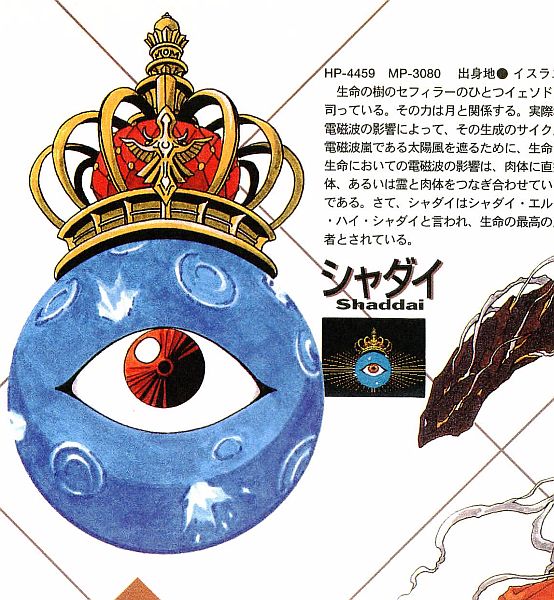
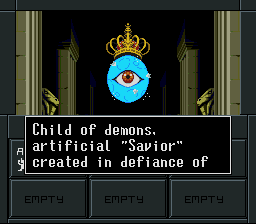
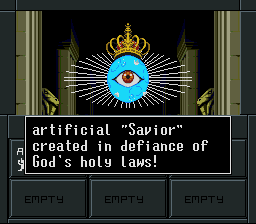
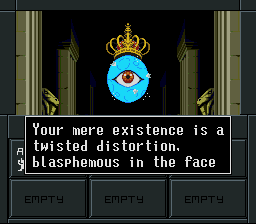
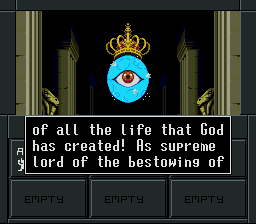
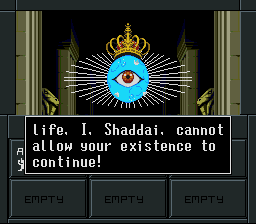
Suuure.
Watch the massacre here on Youtube.
Or here in Dailymotion
Ha! Ha!
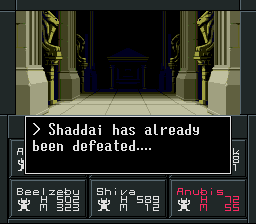
Aww.

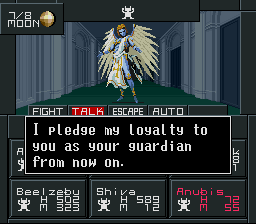
Recruited one of these.
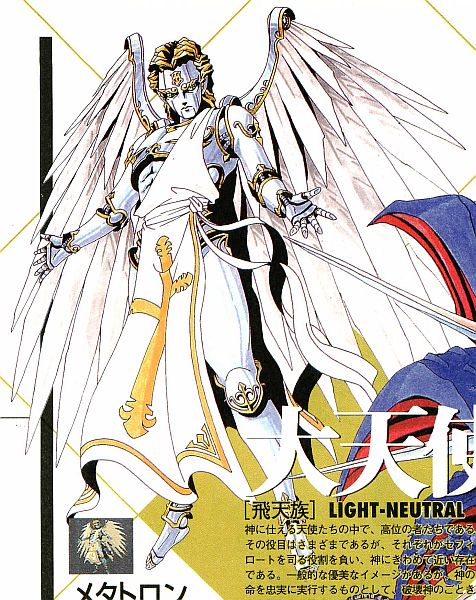
I was expecting something more impressive, like a boss than this. It was displayed prominently in the same page as Satan.
Anyway, it is the top Archangel, so it's good to have it.
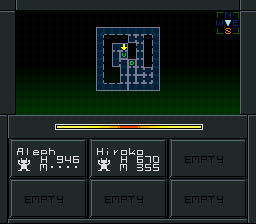
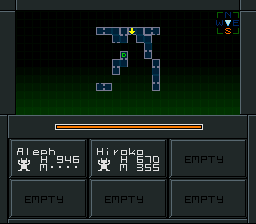
GODDAMN TELEPORTY DUNGEONS.
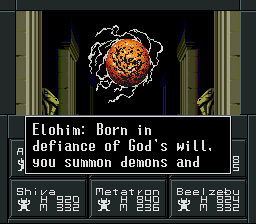
ELOHIM!
Wikipedia posted:
A common name of God in the Hebrew Bible is Elohim (Hebrew: אלהים
; as opposed to other names mentioned in this article, this name also describes gods of other religions.
Despite the -im ending common to many plural nouns in Hebrew, the word Elohim, when referring to God is grammatically singular, and takes a singular verb in the Hebrew Bible. The word is identical to the usual plural of el meaning a god or magistrate, and is cognate to the 'lhm found in Ugaritic, where it is used for the pantheon of Canaanite Gods, the children of El and conventionally vocalized as "Elohim" although the original Ugaritic vowels are unknown. When the Hebrew Bible uses elohim not in reference to God, it is plural (for example, Exodus 20:3). There are a few other such uses in Hebrew, for example Behemoth. In Modern Hebrew, the singular word ba'alim ("owner") looks plural, but likewise takes a singular verb.
Another popular explanation comes from the interpretation of El to mean "power"; Elohim is thus the plural construct "powers". Hebrew grammar allows for this form to mean "He is the Power (singular) over powers (plural)", just as the word Ba'alim means "owner" (see above). "He is lord (singular) even over any of those things that he owns that are lordly (plural)."
Other scholars interpret the -im ending as an expression of majesty (pluralis majestatis) or excellence (pluralis excellentiae), expressing high dignity or greatness: compare with the similar use of plurals of ba`al (master) and adon (lord). For these reasons many Trinitarians cite the apparent plurality of elohim as evidence for the basic Trinitarian doctrine of the Trinity. This was a traditional position but modern Christian theologians now largely accept that this is an exegetical fallacy.[citation needed]
Theologians who dispute this claim, cite the hypothesis that plurals of majesty came about in more modern times. Richard Toporoski, a classics scholar, asserts that plurals of majesty first appeared in the reign of Diocletian (284-305 CE)1. Indeed, Gesenius states in his book Hebrew Grammar 2 the following:
The Jewish grammarians call such plurals … plur. virium or virtutum; later grammarians call them plur. excellentiae, magnitudinis, or plur. maiestaticus. This last name may have been suggested by the we used by kings when speaking of themselves (compare 1 Maccabees 10:19 and 11:31); and the plural used by God in Genesis 1:26 and 11:7; Isaiah 6:8 has been incorrectly explained in this way). It is, however, either communicative (including the attendant angels: so at all events in Isaiah 6:8 and Genesis 3:22), or according to others, an indication of the fullness of power and might implied. It is best explained as a plural of self-deliberation. The use of the plural as a form of respectful address is quite foreign to Hebrew.
The plural form ending in -im can also be understood as denoting abstraction, as in the Hebrew words chayyim ("life") or betulim ("virginity"). If understood this way, Elohim means "divinity" or "deity". The word chayyim is similarly syntactically singular when used as a name but syntactically plural otherwise.
The Hebrew form Eloah (אלוה, which looks as though it might be a singular form of Elohim) is comparatively rare, occurring only in poetry and late prose (in the Book of Job, 41 times). What is probably the same divine name is found in Arabic (Ilah as singular "a god", as opposed to Allah meaning "The God" or "God") and in Aramaic (Elaha). This unusual singular form is used in six places for heathen deities (examples: 2 Chronicles 32:15; Daniel 11:37, 38. The normal Elohim form is also used in the plural a few times, either for gods or images (Exodus 9:1, 12:12, 20:3; and so forth) or for one god (Exodus 32:1; Genesis 31:30, 32; and elsewhere). In the great majority of cases both are used as names of the one God of Israel.
The root-meaning of the word is unknown. One theory is that it may be connected with the old Arabic verb alih ("to be perplexed, afraid; to seek refuge because of fear"). Eloah, Elohim, would, therefore, be "He who is the object of fear or reverence", or "He with whom one who is afraid takes refuge".
In many of the passages in which Elohim occurs in the Bible it refers to non-Israelite deities, or in some instances to powerful men or judges (Exodus 21:6).
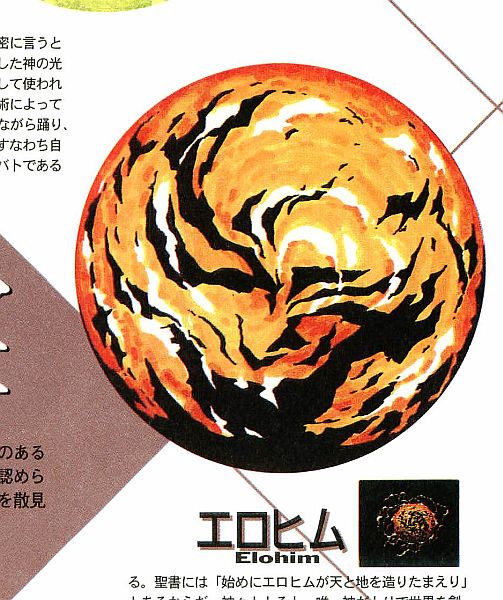
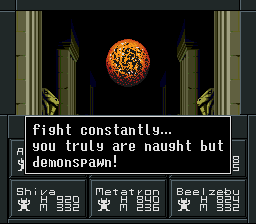


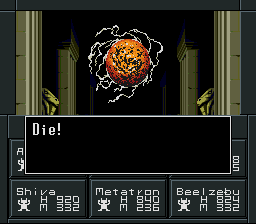
NO. YOU DIE.
Youtube.
Dailymotion.
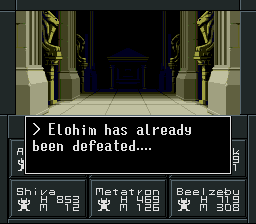
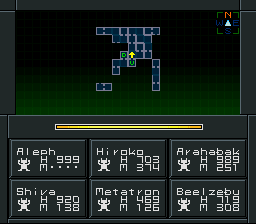
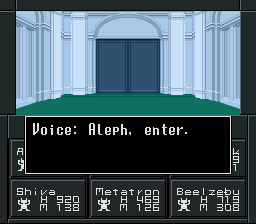
Someone summons Aleph.
IT IS SATAN.
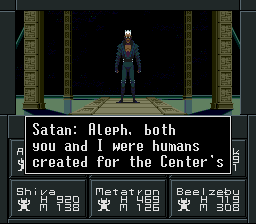

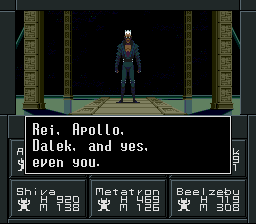
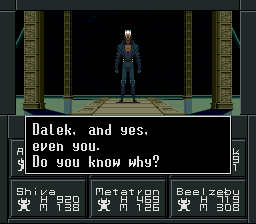
He then transforms.
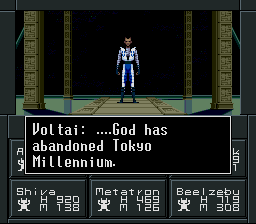
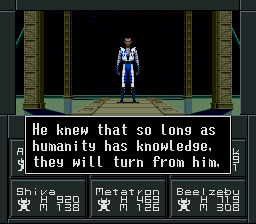
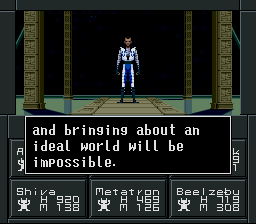
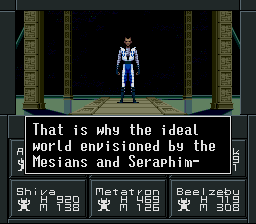
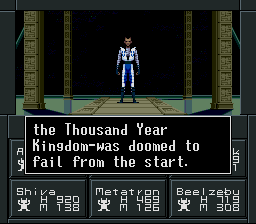
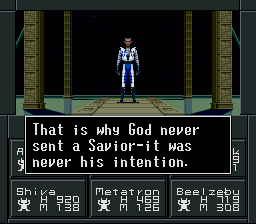
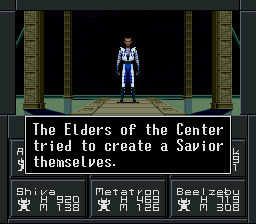

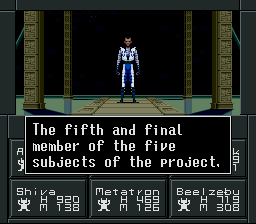

Lies. Vile lies. Aleph won the fight.
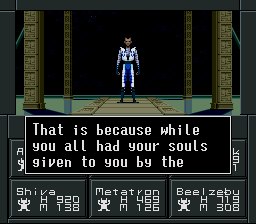
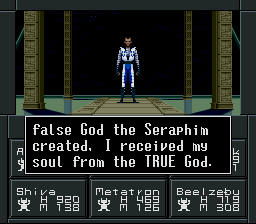
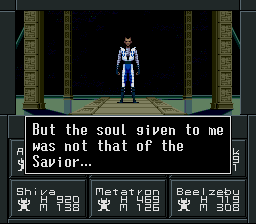
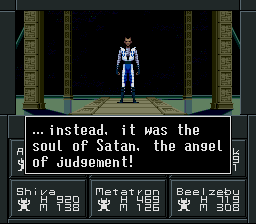
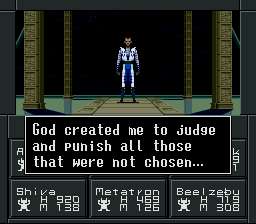
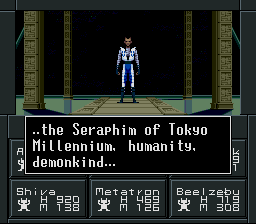
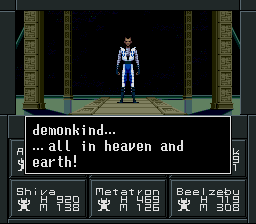


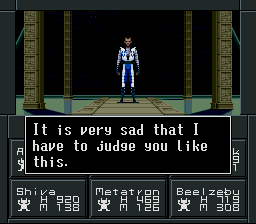
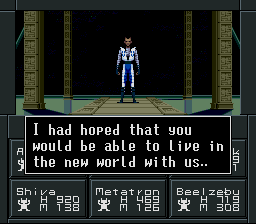
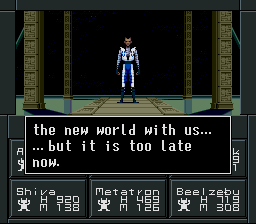
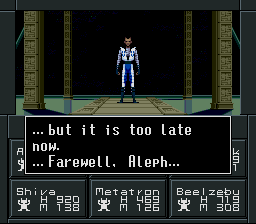
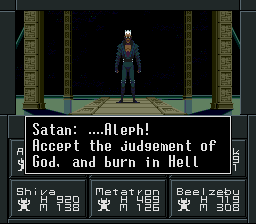
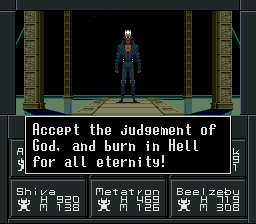
Hooooly shit.

Epic fight.Wikipedia posted:
Satan - from the Hebrew word for "adversary" - is a term that originates from the Abrahamic faiths, being traditionally applied to an angel.
While Hebrew Ha-Satan is "the accuser" — a member of the divine council, who challenged the religious faith of humans, especially in the books of Job and Zechariah — Abrahamic religious belief systems other than Judaism relate this term to a demon, a rebellious fallen angel, devil, minor god and idolatry, or as an allegory for evil.
'Satan' is שָׂטָן Satan in Standard Hebrew, Śāṭān in Tiberian Hebrew, סטנא Saṭänä in Aramaic, Σατανάς Satanás in Koine Greek, اهریمن Satanás in Persian, شيطان Šayṭān in Arabic, ሳይጣን Sāyṭān in Ge'ez, and Şeytan in Turkish.
The word 'Satan', and the Arabic شيطان "shaitan," may derive from a Northwest Semitic root śṭn, meaning "to be hostile," "to accuse."[1] An alternative explanation is provided by the Hebrew in Job 1:7. When God asks him whence he has come, Satan answers: "From wandering (mi'ŝuṭthe earth and walking on it" (מִשּׁוּט בָּאָרֶץ, וּמֵהִתְהַלֵּךְ בָּה
. The root ŝuṭ signifies wandering on foot or sailing. 'Satan' would thus be "the Wanderer."
Youtube SATAN
Dailymotion SATAN
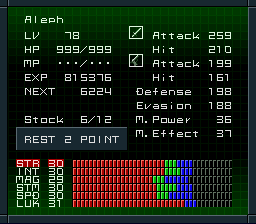
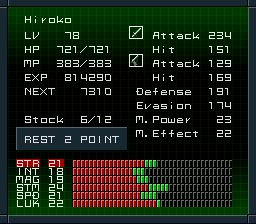
FOUR POINTS.
THE LAST FOUR POINTS OF THE GAME.
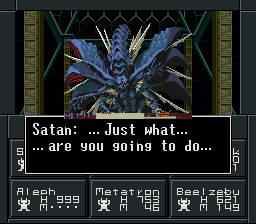

There is nowhere else left to go. only forward remains. Satan is dead.
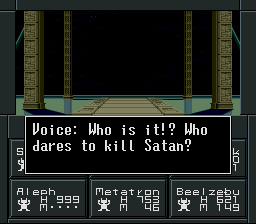
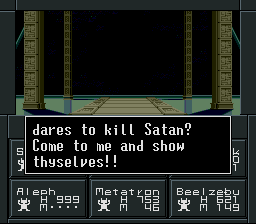
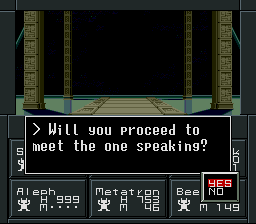
Oh shit.
Four points. Next update is the last.